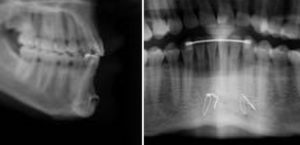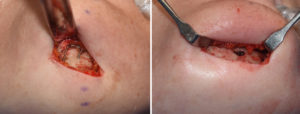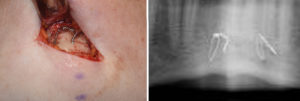Background: There are a versatile numbers of procedures to change the shape of the most protruding structure of the face…the chin. It can fundamentally be increased in size by implants and bone movements but can only be reduced in size by changing the bone. (unless an implant is being removed) As this basic concept suggests, augmentation is ‘easier’ to do by virtue of the different procedures available to do it and the subsequent expansion of the overlying soft tissues. Chin reduction, however, is more difficult as only bone reshaping can be done and the result is highly impacted by how well the overlying soft tissues contract around it.
The most common method of chin reduction in the U.S is a submental bone burring/ostectomy technique. This is because many (or almost all) of the patients are females who have a concomitant soft tissue pad excess. If the soft tissue is not concurrently addressed/removed/tightened, a ptosis will occur as bone support is removed.
An uncommon type of chin reduction is in the patient who has had a prior chin augmentation by bone movement. (sliding genioplasty) (Technically the most common type of chin reduction after chin augmentation is implant removal) The patient has the obvious option of setting back the chin osteotomy. (subtotal or total reverse sliding genioplasty) But to avoid an intraoral osteotomy again the only other option is a submental reduction approach.



Submental chin reduction after a sliding genioplasty is uncommon in females but does avoid the intaroral experience…which is the primary motivation for its use.
Case Highlights:
1) Chin reduction after a sliding genioplasty often requires the removal of the indwelling bone fixation devices.
2) Of all the sliding genioplasty fixation devices to remove, old style wire fixation is usually the easiest…although it is rarely seen anymore.
3) The submental chin reduction technique employs the use of bone shaving and can change all three dimensions of the chin of needed. (horizontal projection, vertical height and width)
Dr. Barry Eppley
Indianapolis, Indiana





